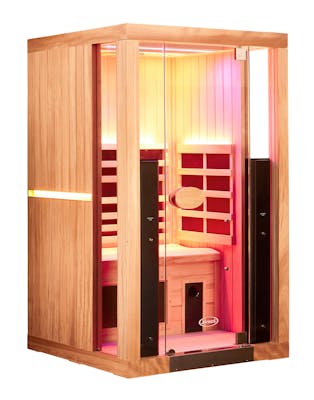Full-Spectrum Heating System
Jacuzzi® saunas use a full-spectrum heating system that combines different infrared wavelengths. Featuring combination mica/carbon and front-facing heaters, this approach ensures maximum therapeutic benefits.
Unlike most other sauna brands that only include far infrared, Jacuzzi® saunas offer near, mid, and far infrared heating. This combination enhances user comfort and safety, providing a more effective and enjoyable sauna experience.
Durability and Longevity
Crafted with furniture-grade materials, Jacuzzi® saunas offer both elegance and durable resilience. Using premium products like mahogany wood and thick glass, they ensure a long lifespan and consistent performance.
Built with certified mahogany wood and metal thresholds, Jacuzzi® saunas withstand regular use. Thermally modified wood is recommended for its durability and resistance, ensuring long-term reliability in your wellness routine.
Advanced Therapy Options
Jacuzzi® saunas provide advanced therapy options like therapeutic red light therapy and high-output chromotherapy. Red light therapy penetrates deeply into the skin, promoting healing and rejuvenation, making it a valuable addition to any wellness routine.
Chromotherapy uses colored light to influence mood and promote relaxation, enhancing the overall sauna experience. The combination of red light therapy and chromotherapy in Jacuzzi® saunas creates a holistic approach to enhance physical and mental well-being.
Installation and Maintenance of Indoor Saunas
Jacuzzi® Indoor Saunas are distinguished by their high standards of craftsmanship and premium materials for durability. Regular maintenance checks help identify potential issues before they become significant problems. Proper installation and maintenance are crucial to ensuring the longevity and effectiveness of your sauna.
When installing an indoor sauna, consider factors like location, dedicated electrical circuit, and proper insulation to ensure safe and effective operation. Additionally, proper ventilation is crucial to manage humidity levels and prevent mold growth.
Installation Process
When installing an indoor sauna, consider the following:
- Choose the right location and ensure a dedicated electrical circuit to prevent electrical issues.
- Provide proper insulation and ventilation for effectiveness and safety.
- For complex installations, professional installation is recommended to meet safety standards and ensure proper functionality.
Proper ventilation manages humidity levels and prevents mold growth, ensuring your sauna remains a safe and enjoyable space for years.
Maintenance Tips
Regular maintenance is essential for long-term enjoyment of your indoor sauna. Using filtered or soft water prevents limescale buildup, maintaining heater efficiency and longevity. Keeping the sauna clean and dry after each use prevents mold and mildew, ensuring a safe and hygienic environment.
For traditional saunas, consider the following maintenance tips:
- Maintain humidity levels using a bucket and ladle to enhance comfort.
- Regularly check and maintain components like the heater and ventilation system.
- Identify potential issues early to keep your sauna in top condition.
Cost Considerations and Long-term Value
Investing in a home sauna is a significant decision that involves considering both the initial costs and the long-term value. Home saunas typically range from $3,000 for basic models to over $20,000 for custom designs. However, the long-term benefits, including savings on spa visits and enhanced wellness, often outweigh the initial investment.
Indoor saunas have lower operating costs compared to outdoor saunas. Their long-term value includes financial savings and significant health and wellness benefits, making them a worthwhile investment for many homeowners.
Initial Investment
Home sauna kits are often a cost-effective option, typically ranging from $1,500 to $10,000. Prefabricated sauna kits generally offer a more affordable installation option compared to custom-built saunas. The price of indoor saunas can vary based on materials, size, and additional features like lighting and sound systems.
Although the initial investment might seem high, consider the long-term savings and the value a home sauna adds to your daily life. Whether you choose a basic kit or custom design, the benefits of a personal wellness space are invaluable.
Long-term Savings and Benefits
Investing in a sauna can lead to significant savings on spa visits. Owning a sauna reduces reliance on spa visits, saving money over time. Additionally, having a sauna at home provides the convenience to make a purchase and enjoy its benefits anytime, without travel or appointments.
Owning a home sauna can provide substantial long-term savings by reducing wellness-related expenses. The enhanced health benefits, including improved circulation, detoxification, and stress relief, contribute to a better quality of life and long-term wellness.
Comparing Indoor and Outdoor Saunas
Both indoor and outdoor saunas offer unique benefits and considerations. Outdoor saunas provide a distinctive experience in a natural setting, enhancing relaxation. However, individuals with limited outdoor space might find indoor saunas more suitable as they fit easily within homes.
Installing either type of sauna can enhance property value, making homes more appealing to potential buyers during a sale. The choice largely depends on personal preferences and available space, as each sauna type offers distinct advantages.

















